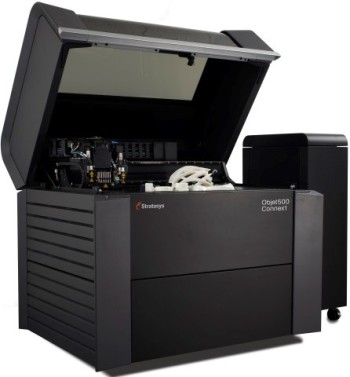Objet’s triple-jetting technology lets the Connex1 3D production system combine as many as three base resins in a single build without assembly or post-processing.
3D print multi-material jigs, assembly fixtures and tooling, and simulate overmolding with fine layer that promote accuracy. A choice of 14 photopolymers can simulate rubber, polypropylene and standard manufacturing plastics.
The Objet500 Connex1 has a large 2,350 in3 build volume with dimensions of 19.3 in. x 15.4 in. x 7.9 in. (490 x 391 x 200mm)
Because of its unique PolyJet technology, the Connex1 can build objects by mixing any of its model materials. That allows users to vary their model’s material properties within a single build.
Given its large build volume, some users may prefer to order their Connex1 with an expanded material closet. This expanded material closet allows large prints to run unattended, making the system productive even when no one’s at the office. If there is a need to swap material, the Connex1 can pause itself so that hot swaps of resin containers can be made on the fly.
The Objet500 Connex1 uses PolyJet technology to build models from UV-curable liquid resins. At the outset of a print, the Connex1 will jet several layers of support material onto the print bed. Users can later separate the support material from the finished model.
The Objet500 Connex1 begins building a model by jetting user-defined resins onto the support base. As the print head deposits material, it’s followed by a UV-curing lamp that is embedded within the print arm. Right after the resin is jetted, the UV-lamp passes over the material rendering it into a cured plastic. The print head will also deposit support material where required to compensate for voids, overhangs or other areas that require support. This process keeps going to build the model layer by layer until a job is complete.
Users can remove the support base away from the print bed with a spatula once the print is done. To detach any remaining support material, models have to be washed in a high-pressure water jet cabinet. The process for washing a model is relatively quick. Users report that the support material abandons its position without much fuss.
The model then has to dry before further post processing like painting or sanding can be done. With relatively little work, the Objet500 Connex1 models can be transformed into objects that look like full color, injection molded parts.
Southern Germany’s Robert Seuffer GmbH manufactures electronic components that are used in households, commercial vehicles and automotive plants. Many of their designs are used by consumers, so they have to be able to stand up to repeated human contact. Seuffer’s engineers are constantly testing whether their products can protect internal electronics, withstand corrosive elements and a myriad of other issues.
Read more at ENGINEERING.com



